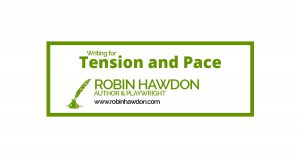Emotional Involvement is perhaps the most crucial item in a writer’s inventory. It doesn’t matter how brilliant your concept, how sparkling your dialogue, how meaningful your insights – if you as the writer don’t have that emotional involvement at every point of the story, it will lack conviction and intensity.
This is what makes the task so mentally exhausting, and why you need to take a break every so often.

I find that the hardest work comes in the revising. Having completed the main bones of the section I’m working on, I then go over and over it (whole blog on revising to come) actually imagining each moment, feeling each description or verbal exchange, and considering whether I can take it further or make it more potent.
The best way to illustrate the process is to use a couple of examples taken randomly from my novel ‘Number Ten’:-
‘At that moment the Prime Minister entered, the tall figure of his Chief of Staff at his side, followed by the Home Secretary and a couple of others.’
OK, that tells the story. But it doesn’t tell the reader anything else of interest. Next draft –
‘At that moment the Prime Minister entered, the tall figure of his Chief of Staff at his side, followed by the Home Secretary and a couple of others. A bevy of formal suits, of different shapes and sizes, yet in their expressions all oddly conforming.’
A bit more interesting, but still not very insightful. Needs more colour –
‘At that moment the Prime Minister entered, the tall figure of his Chief of Staff at his side, followed by the Home Secretary and a couple of others. A bevy of formal suits, of different shapes and sizes, yet in their expressions all oddly conforming. The politician’s face of intensity and wariness.’
That paints the picture much more vividly. One could expand even further, but the reader has probably read enough about politicians for the moment!
Another example –
‘Not for the first time, his brain seemed to be malfunctioning. The circumstances laid before it fitted no intelligible pattern that he could understand. He was in love with Andrea, of that he had no doubt. They had survived a whole sequence of life-threatening events together. But now he was confronted by a stranger.’
That describes a crisis in the relationship between the pair at the centre of the story, but it doesn’t do justice to its intensity. We need more –
‘Not for the first time, his brain seemed to be malfunctioning. The circumstances laid before it fitted no intelligible pattern that he could understand. He was in love with Andrea, of that he had no doubt. They had survived a whole sequence of life-threatening events together. They had proved themselves an effective team, they had achieved a precious mutual harmony, they had reached heights of physical love beyond anything he had experienced. But now he was confronted by a stranger. Someone whose thoughts, whose actions, whose very being were a mystery to him.’
Better. Emotional Involvement exists, but can his own feelings be painted more vividly?
Add this at the end:-
‘ He felt like an abandoned traveler, lost in a desert with no landmarks.’
OK it’s not Emily Bronte, but it brings the hero’s mental predicament to life adequately.
All this also explains why many first drafts of novels involve less than 80,000 words, but when seriously rewritten can expand to 100,000 or even more. But as I’ve said, the emotional involvement is tiring!
The benefit, as I talked about in previous blogs, is that the exercise keeps the brain fit, in the same way that physical exercise does the body.
For an example of this on a much more epic scale, take a look at A Rustle in the Grass
Subscribe to Books & Stuff

Email Robin for a FREE online flip-book edition of 'Dinner With Churchill' (or his previous books, 'The Land, The Land' and 'Number Ten').










Hi Robin, yet another helpful insight. However, I’d love to read the promised blog on revision since this is where I struggle most.